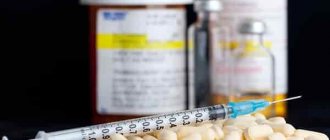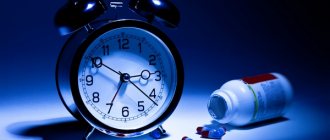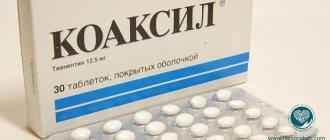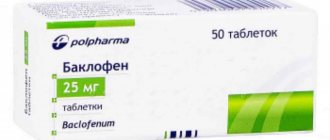Barbiturates (barbiturates) - what is it? The list of medications is quite extensive; what medications contain this drug? This is a class of drugs that contain barbituric acid. They have a sedative, anticonvulsant, sedative effect, relieve anxiety and restlessness. At increased dosages of drugs, barbitura has a narcotic effect and has a depressing negative effect on the central nervous system.
How does barbiturate addiction occur?
If you try barbiturates once or take them according to a doctor's prescription, gradually reducing the dose, you will not feel any narcotic effect. On the contrary, the drug will help you calm down, fall asleep, and relieve anxiety or irritation. If you don’t follow the specialist’s instructions, even a housewife can get hooked on the drug, thinking that she is being treated. As a rule, addiction is recognized quite late. However, as a rule, taking barbiture as a drug is used by many pharmacy drug addicts precisely to obtain euphoria. They are called barbiturists.
Content:
- Properties
- What applies to barbiturates: list
- Mechanism of action in the body
- Development of addiction
- Acute barbiturate intoxication
- Overdose
- Consequences of chronic intoxication
- Signs of use
- Treatment
Barbiturates are synthetic chemical compounds, derivatives of barbituric acid, which have sedative, hypnotic, and muscle relaxant effects. Previously prescribed for insomnia, anxiety, mental tension, arterial hypertension, and convulsive syndrome. Now they are used as a premedication before surgery to put a person into anesthesia sleep. Treatment with barbiturates is prescribed if necessary to relieve agitation or increase the level of sedation. Their long-term use leads to addiction and drug dependence.
What are barbiturates and what is the history of their discovery?
Barbiturates include a large group of medications that have a depressant effect on the central nervous system (CNS). Moreover, the degree of inhibition depends on the dosage of the drug and varies from a mild sedative and hypnotic effect to a state of anesthesia.
Until recently, barbiturates were prescribed as a sedative, a sleep aid, and a sleep aid. Now their use is significantly limited due to the narrow therapeutic range, which can easily lead to overdose and intoxication, as well as due to the occurrence of addiction and even the formation of persistent dependence. The history of the discovery and derivation of the name barbituric acid is quite interesting and unusual. It was born in 1864 in the laboratory of a chemist from Munich, Adolf Bayer, and this date coincided with the feast of St. Barbara, in German urates Barbar - hence the name barbiturates. Another version suggests that Bayer named the new substance after his then-girlfriend Barbara.
Since then, more than 2.5 thousand barbiturates have been synthesized, of which 50 were produced for commercial sale. Now there are a little more than 10 of them. According to WHO recommendations, the root barb and the suffix al are often used to designate hypnotic barbiturates, for example, barbital, allobarbital, phenobarbital, etc. In addition, the prefix before the root indicates the features of the chemical formula: thio - the presence of a sulfur atom, cyclo - the cyclic (closed) spatial structure of the formula, vinyl - the presence of a vinyl group, phenyl - a phenyl group (benzene radical), etc. As I already said, all barbiturates are derivatives of barbituric acid. Their synthesis occurs as a result of condensation of urea with dialkylmalonic acids during reflux in absolute ethyl alcohol with the addition of sodium ethoxide. This is a classic version of the synthesis of barbiturates, although there are others, for example, replacing acids with esters, and ethanol with methanol. But let's not go too deep into these issues. Much more interesting are the mechanisms of the physiological action of barbiturates on the central nervous system.
What applies to barbiturates: list
Barbiturate derivatives have a depressant effect on the central nervous system. The therapeutic effect depends on the dose taken - from mild sedation to anesthesia or atonic coma. drugs have the greatest toxic effect
- Amobarbital;
- Barbital;
- Heptobarbital;
- Phenobarbital;
- Cyclobarbital;
- Diallylbarbituric acid.
They cause health problems in the form of acute poisoning from one specific dose. All barbiturates are conventionally divided into groups of short-term, long-acting and long-acting:
- The first include anesthetics, which are administered in preparation for operations for sedation and normalization of blood pressure. The calming effect occurs immediately and lasts 30 minutes. (Thiopental, Hexonal)
- The second group of barbiturates is used for chronic insomnia, atherosclerosis, as well as to lower cholesterol levels and relieve angina. These include: Barbamil, Nembutal. Valid for up to 8 hours.
- The third includes Phenobarbital, Veronal. Use only under medical supervision for epilepsy and convulsive syndrome.
When abused, drug addiction develops. In small doses, barbiturates are included in many sedatives, regulating the autonomic nervous system, and suppressing pain.
Barbiturates – what are they?
A fairly large group of barbituric acid derivatives have become medicines.
They are called barbiturates. The first representative of the family and a weapon in the hands of psychiatrists was Veronal, used back in 1903. Ten years later, the stronger Phenobarbital appeared. Since then, the list of barbiturate drugs that depress brain centers has often been replenished and expanded. Now it contains three pharmacological groups divided by duration and speed of action:
- Kemital, Cyclobarbital, Thiopental and other drugs that are interesting to anesthesiologists cause sleep for 3-4 hours within 15 minutes after administration.
- Medium-duration barbiturates, revered by psychiatrists, are Seconal, Amytal, Nembutal. In international drug jargon, these substances received more eloquent names - “Red Devils”, “Green Dragons”.
- Long-term anti-epilepsy drugs – Phenobarbital and analogues.
Mechanism of action in the body
A single dose slows down the activity of the central nervous system, reduces anxiety, nervous and muscle tension. Large doses taken in a calm, relaxed state induce sleep. In a stimulating environment, the effect of barbiturates resembles alcohol intoxication and has the following manifestations:
- euphoria;
- staggering;
- slow breathing and reflexes;
- disorientation;
- confused speech.
With the simultaneous combination of barbiturates and alcohol, a mutual enhancement of the effect occurs - synergy, that is, a deeper depression of the nervous system. The likelihood of overdose, respiratory arrest and death is very high, so these substances cannot be combined. In addition, barbiturates potentiate the effect of analgesics.
Symptom of addiction
So, we have already found out what a barbiturate is and when it is used. Now it’s worth clearly articulating what symptoms indicate the development of dependence on the drug. Under the influence of barbiturates, a person becomes sleepy, experiencing indifference to stress factors. Physical activity and mental activity slow down. When the effect of the drug ends, nervousness, irritability, absent-mindedness, and changes in reflexes appear.
With regular and long-term use of medications, severe withdrawal syndrome may develop. As a rule, a deterioration in well-being occurs when the drug is abruptly discontinued: a person experiences restlessness, anxiety, gets tired quickly, gets cold (barbiturates constrict blood vessels), and sleeps poorly. In the most severe cases, abdominal pain, vomiting and nausea occur. The patient loses weight, loses appetite and interest in life. On the fifth day after stopping the medication, convulsions may occur (without loss of consciousness).
Development of addiction
Barbituric acid derivatives have become the subject of abuse among drug-dependent patients. Moreover, the use is carried out not only in its pure form. Opioid drugs and alcohol are added to them to increase intoxication.
When taken for 6–12 months, mental dependence develops and tolerance increases. To obtain the desired effect, the dose must be constantly increased. A secondarily expressed desire appears - in a state of altered consciousness, a person has a desire to add more drugs. Because of this, the risk of overdose and death due to depression of consciousness and breathing increases.
In patients with drug addiction, in the case of intravenous administration of a drug to enhance the euphoria from the psychoactive substance taken, addiction develops within a few days. After some time, physical dependence is formed, which is manifested by the appearance of abstinence. Within 24 hours after stopping the drug, the following symptoms appear:
- anxiety and panic attacks;
- irritability and low mood;
- tearfulness;
- lack of sleep;
- pressure instability;
- pain in the joints, under the breasts;
- tremor of hands, tongue, eyelids;
- nausea and vomiting;
- convulsions.
This condition is similar to drug withdrawal. Unable to withstand the torment, the patient begins to look for ways to get prohibited pills.
Barbiturate addiction – what is it and how is it treated?
Dependence on barbiturates (barbituratomania) is much more dangerous than on opiates. It develops at the physiological level and is based on a change in the mechanism of action, which at small and medium doses normally reduces to such effects as: • Blocking the acetylcholinergic system. • Strengthening the inhibitory role of GABA. • Impaired transmission of neurotransmitters through the lipid membranes of neurons.
When addiction occurs and the dosage increases, everything happens exactly the opposite. Instead of a calming and relaxing effect, agitation, loss of self-control and aggression occur, sometimes accompanied by hallucinations. The danger of barbiturate mania is primarily associated with a possible overdose and severe intoxication due to barbiturate poisoning. There are 4 stages of barbiturate poisoning, characterized by the following symptoms: • Apathy, drowsiness, inhibition of reactions. • Difficulty swallowing and breathing, tongue retraction, hyperthermia (high temperature), superficial coma with loss of consciousness. • Deep coma with a drop in temperature, respiratory paralysis and failure of vital organs. • Post-comatose state of restoration of basic vital functions.
Drug addicts with more than 0.5 years of experience may experience withdrawal symptoms that develop when trying to reduce the dosage or completely abandon barbiturates. Read more about obsessive-compulsive disorder.
There is no specific antidote for barbiturate poisoning, so it is treated like any intoxication - with accelerated elimination and symptomatic therapy. If no more than 8 hours have passed since taking the barbiturate, then gastric lavage with a 2% soda solution, taking sorbents and a laxative will be effective.
If respiratory function is impaired, 1 ml of Lobelin is injected subcutaneously and inhalation therapy with an oxygen-carbon mixture is carried out. To recover from a coma, barbiturate antagonists are used - cordiamine, caffeine, strychnine. By the way, even long-term use of the seemingly harmless Corvalol leads to the appearance of barbiturates in the urine. You can quickly remove them by drinking plenty of fluids and taking diuretics. Based on what has been said, the question: barbiturate - what is it, a medicine or a drug, can be answered unequivocally. When used once or as recommended by a doctor, it is a medicine that helps you calm down, fall asleep, and relieve anxiety and concern. If the dosage is exceeded and uncontrolled constant use, any barbiturate is a drug, and people who regularly take barbiturates for euphoria are pharmacy drug addicts, or barbiturists. It must be said that even heart patients who constantly take medications containing barbiturates run the risk of becoming a victim of addiction to them and will not be able to stop using them on their own. To achieve an effect, they will require an increasingly larger dosage and this can all result in drug addiction, and sometimes even lead to acute poisoning. Having a cumulative effect, barbiturates can accumulate in the body, which can lead to an overdose even when taking a completely harmless dose of the drug. It is unknown when just one tablet can lead to acute poisoning. How to get rid of barbiturate mania? First of all, contact specialists at a private or public drug treatment center. Treatment includes detoxification measures, complete removal of barbiturates from the body, medication or psychological treatment, a rehabilitation period, and periodic consultations with the treating psychiatrist-narcologist.
Acute barbiturate intoxication
Outwardly, it resembles alcohol intoxication. The effect lasts for several hours, since drugs of medium duration of action are mainly used. After taking the medicine the following sensations occur:
- slight excitement;
- fun;
- disinhibition of sexual and aggressive drives;
- euphoria.
A secondary attraction appears. A person begins to add doses and as a result the following symptoms develop:
- lethargy;
- incoordination of movement;
- difficulty concentrating;
- slow speech;
- hypomnesia;
- emotional lability.
It all ends in deep, long sleep of varying degrees of duration. On average 2-4 hours, but can last up to 8-10 hours, depending on how much of the drug is taken.
How did the use of barbiturates in medicine evolve?
Veronal, which I have already mentioned, was used as a sedative and the first sleeping pill. Barbiturates were first introduced into medical practice in 1903, when barbital received the market name "Veronal". Until 1960, the popularity of barbiturates as anti-anxiety and hypnotic drugs was growing, but then there was a decline in their demand. This was explained by the development of addiction and the formation of drug dependence with their long-term use. Therefore, preference began to be given to safer benzodiazepine drugs with the same therapeutic effect. Read more about nootropic drugs. By the way, the problem of addiction to barbiturates was hushed up for a long time, although doctors have been paying attention to it since the 30s of the last century. At the same time, barbiturate-dependent drug addicts prefer short- or medium-acting barbiturates, such as Seconal, Amytal or Nembutal, figuratively calling them “red devils” or “green dragons” in international drug jargon. In veterinary medicine, the barbiturate pentobarbital is used for analgesia and euthanasia.
Overdose
After 2–3 years of regular use, the need to increase the dose decreases and it stabilizes. The duration of this period can be several years. Then the dose is reduced, and at this stage overdoses often occur, which have the following symptoms:
- dizziness;
- nausea, vomiting;
- cutting pain in the eyes;
- salivation;
- profuse sweat.
Then coma develops, respiratory and cardiac arrest. Having noticed such a condition of the patient, it is necessary to call a specialized team and begin artificial ventilation of the lungs before its arrival.
Consequences of chronic intoxication
With continuous use of drugs for more than 3 weeks, anemia occurs in combination with liver dysfunction and severe headache. Nervous processes are disrupted and slowed down, the following appear:
- speech disorders;
- the clarity of visual perception deteriorates;
- insomnia.
With long-term use - barbituric dementia with decreased ability to judge, impaired attention and memory. Neurological symptoms appear:
- hypomimia;
- tremor;
- decreased tendon reflexes;
- change in handwriting;
- slurred speech.
The drug addict can no longer perform his usual duties. Gross personality changes occur, the pace of brain processes slows down, and social maladjustment develops. Treatment with a gradual reduction in dosage is necessary. Abuse of barbiturates turns patients into weak-minded, but easily excitable subjects.
Signs of use
You can understand that your loved one has become addicted by two of his states:
- Intoxication - when a person is in euphoria, relaxed and inhibited, does not immediately hear the question addressed to him, reacts inadequately, slowly, it is difficult for him to concentrate, memory and attention disorders are observed. He wants to be left alone. The euphoria phase ends with deep, long sleep.
- Withdrawal or withdrawal - when the patient experiences a physical and mental need to use, is anxious, excited, he may be paranoid, he tries to leave home to get a drug.
Such repeated emotional swings should alert you. It is necessary to consult a narcologist and undergo a laboratory examination. Barbiturates are determined using the classic test, urine and blood. The doctor will conduct a psychological conversation with the patient, find out the degree of neglect of the situation, types of use - pure or combined, and prescribe therapy.
Treatment
It is carried out according to the classical scheme:
- detoxification in a hospital - complete cleansing of the drug from the body;
- restoration of losses in organs and systems, especially the brain and liver, since they are damaged more than others;
- rehabilitation - correction of beliefs, formation of new behavior patterns, group and individual psychotherapy.
After the rehabilitation course, the patient is offered outpatient psychotherapy with a doctor, or self- and mutual help groups of anonymous drug addicts. Subsequently, follow-up with a narcologist.
Barbiturates. How to remove it from the body?
Even long-term use of completely harmless Corvalol by heart patients or easily excitable patients leads to the appearance of barbituric acid derivatives in the urine.
Such substances are excreted through the kidneys. The time for complete removal depends on their condition and the overall rate of metabolic processes and internal reactions. Therefore, the answer to how to quickly remove barbiturates from urine is quite simple.
You can drink more water and take diuretics, but it is better to trust a professional narcologist. Call 8 (495) 150-85-96
Literature:
- Voronkov G. L., Vidrenko A. E., Shevchuk I. D. Directory of a psychiatrist. Publishing house "Health" 1990 - 350 p.
- Narcology: national guide/Ed. N. N. Ivanets, I. P. Anokhina, M. A. Vinnikova. - M.: GEOTAR-Media, 2008. - 720 p.
- Zakharchenko M. Yu. Barbiturates, benzodiazepines, anabolic steroids: history of creation, action, analysis. Educational and reference manual / M. Yu. Zakharchenko, I. N. Melnikov, D. V. Kairgaliev; edited by S. Ya. Pichkhidze. —Saratov: KUBiK, 2015 — 189 p.










